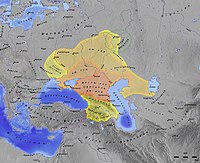
Photo from wikipedia
Although winter lambing practices (WL) have been shown to be a ‘win-win’ strategy for reducing the degradation of grasslands and improving herder livelihood in the pastoral regions of China, the… Click to show full abstract
Although winter lambing practices (WL) have been shown to be a ‘win-win’ strategy for reducing the degradation of grasslands and improving herder livelihood in the pastoral regions of China, the adoption rate is still low. A survey was conducted to explore herders’ opinions of WL and other factors which influenced the adoption in the desert steppe region of Inner Mongolia, China. Herders who have spring lambing practices generally hold unfavourable opinions about WL. Most have only heard about WL but did not understand the detailed information of implementation or how it increases income. Herder ethnical background, distance to market and neighbours’ choices significantly affected the adoption rate. Han herders were more likely to adopt WL than Mongolian herders. Proximity to market led herders to be more market-focused and to adopt WL. Herders were more inclined to make the same choices as their neighbours. The results showed that herders were prepared to change and were carefully assessing the gains and losses of adopting WL. Results had implications for improving the adoption rate for WL and other livestock management practices in China.
Journal Title: Rangeland Journal
Year Published: 2018
Link to full text (if available)
Share on Social Media: Sign Up to like & get
recommendations!